|
项目 |
内容 |
|
这个作业属于哪个课程 |
|
|
这个作业的要求在哪里 |
https://www.cnblogs.com/nwnu-daizh/p/12031970.html |
|
作业学习目标 |
(1) 掌握Java应用程序的打包操作; (2) 掌握线程概念; (3) 掌握线程创建的两种技术。 (4) 学习设计应用程序的GUI。 |
第一部分:总结教材14.1-14.3知识内容
14.1 什么是线程
多线程程序在较低的层次上扩展了多任务的概念:一个程序同时执行多个任务。通常,每一个任务称为一个线程( thread), 它是线程控制的简称。可以同时运行一个以上线程的程序称为多线程程序(multithreaded)。
sleep 方法可以抛出一个 IntermptedException 异常。
【API】java.Iang.Thread 1.0:
static void sleep(long minis)
休眠给定的毫秒数。
参数: millis 休眠的毫秒数
14.1.1 使用线程给其他任务提供机会
下面是在一个单独的线程中执行一个任务的简单过程:
1 ) 将任务代码移到实现了 Runnable 接口的类的 run 方法中。
由于 Runnable 是一个函数式接口,可以用 lambda 表达式建立一个实例
Runnable r = () -> { task code };
2 ) 由 Runnable 创建一个 Thread 对象
Thread t = new Thread(r);
3 ) 启动线程
t.start();
注释: 也可以通过构建一个 Thread 类的子类定义一个线程 。然后, 构造一个子类的对象, 并调用 start 方法。 不过, 这种方法已不再推荐。 应该将要并行运行的任务与运行机制解耦合。如果有很多任务, 要为每个任务创建一个独立的线程所付出的代价太大了。 可以使用线程池来解决这个问题。
警告: 不要调用 Thread 类或 Runnable 对象的 run 方法。 直接调用 run 方法, 只会执行同一个线程中的任务, 而不会启动新线程。 应该调用 Thread.start 方法。这个方法将创建一个执行 ran 方法的新线程
构造一个新线程, 用于调用给定目标的 run() 方法。
void start( )
启动这个线程, 将引发调用 run() 方法。这个方法将立即返回, 并且新线程将并发运行。
void run( )
调用关联 Runnable 的 run 方法。
必须覆盖这个方法, 并在这个方法中提供所要执行的任务指令。
没有可以强制线程终止的方法。然而, interrupt 方法可以用来请求终止线程。
要想弄清中断状态是否被置位,首先调用静态的 Thread.currentThread 方法获得当前线程, 然后调用 islnterrupted 方法
当在一个被阻塞的线程(调用 sleep 或 wait ) 上调用 interrupt 方法时, 阻塞调用将会被Interrupted Exception 异常中断。
注释: 有两个非常类似的方法, interrupted 和 islnterrupted。Interrupted 方法是一个静态方法, 它检测当前的线程是否被中断。 而且, 调用 interrupted 方法会清除该线程的中断状态。 另一方面, islnterrupted 方法是一个实例方法, 可用来检验是否有线程被中断。调用这个方法不会改变中断状态。
【API】java.Iang.Thread 1.0:
向线程发送中断请求。线程的中断状态将被设置为 true。如果目前该线程被一个 sleep调用阻塞,那么, InterruptedException 异常被抛出。
static boolean interrupted()
测试当前线程(即正在执行这一命令的线程)是否被中断。注意,这是一个静态方法。这一调用会产生副作用—它将当前线程的中断状态重置为 false。
boolean islnterrupted()
测试线程是否被终止。不像静态的中断方法,这一调用不改变线程的中断状态。
static Thread currentThread()
返回代表当前执行线程的 Thread 对象
线程可以有如下 6 种状态:
- New (新创建)
- Runnable (可运行)
- Blocked (被阻塞)
- Waiting (等待)
- Timed waiting (计时等待)
- Terminated (被终止)
要确定一个线程的当前状态, 可调用 getState 方法。
14.3.1 新创建线程
当用 new 操作符创建一个新线程时, 如 newThread®, 该线程还没有开始运行。这意味着它的状态是 new。当一个线程处于新创建状态时, 程序还没有开始运行线程中的代码。在线程运行之前还有一些基础工作要做。
14.3.2 可运行线程
一旦调用 start 方法,线程处于 runnable 状态。
现在所有的桌面以及服务器操作系统都使用抢占式调度。但是,像手机这样的小型设备可能使用协作式调度。
记住,在任何给定时刻,二个可运行的线程可能正在运行也可能没有运行(这就是为什么将这个状态称为可运行而不是运行。
14.3.3 被阻塞线程和等待线程
当线程处于被阻塞或等待状态时,它暂时不活动。它不运行任何代码且消耗最少的资源。直到线程调度器重新激活它。 细节取决于它是怎样达到非活动状态的。
当一个线程试图获取一个内部的对象锁(而不是 javiutiUoncurrent 库中的锁,) 而该锁被其他线程持有, 则该线程进人阻塞状态 。当所有其他线程释放该锁,并且线程调度器允许本线程持有它的时候,该线程将变成非阻塞状态
当线程等待另一个线程通知调度器一个条件时, 它自己进入等待状态有几个方法有一个超时参数。调用它们导致线程进人计时等待(timed waiting) 状态。这一状态将一直保持到超时期满或者接收到适当的通知
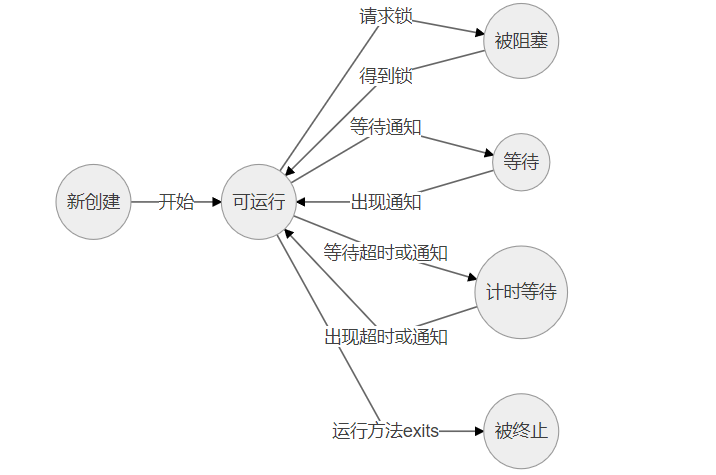
14.3.4 被终止的线程
因为一个没有捕获的异常终止了 run 方法而意外死亡
【API】java.iang.Thread 1.0:
等待终止指定的线程。
void join( long millis )
等待指定的线程死亡或者经过指定的毫秒数。
Thread.State getState () 5 . 0
得到这一线程的状态;NEW、RUNNABLE BLOCKED、 WAITING 、TIMED_WAITNG或 TERMINATED 之一。
停止该线程。这一方法已过时
void suspend()
暂停这一线程的执行。这一方法已过时。
void resume()
恢复线程。这一方法仅仅在调用 suspend() 之后调用。这一方法已过时
第二部分:实验部分
实验1: 导入第13章示例程序,测试程序并进行代码注释。
测试程序1
l 在elipse IDE中调试运行教材585页程序13-1,结合程序运行结果理解程序;
l 将所生成的JAR文件移到另外一个不同的目录中,再运行该归档文件,以便确认程序是从JAR文件中,而不是从当前目录中读取的资源。
l 掌握创建JAR文件的方法;
package resource;
import java.awt.*;
import java.io.*;
import java.net.*;
import java.util.*;
import javax.swing.*;
/**
* @version 1.41 2015-06-12
* @author Cay Horstmann
*/
public class ResourceTest
{
public static void main(String[] args)
{
EventQueue.invokeLater(() -> {
JFrame frame = new ResourceTestFrame();
frame.setTitle("ResourceTest");//设置标题
frame.setDefaultCloseOperation(JFrame.EXIT_ON_CLOSE);//关闭界面的操作
frame.setVisible(true);//设置可见性
});
}
}
/**
* 一个加载图像和文本资源的框架
*/
class ResourceTestFrame extends JFrame
{
//定义像素长和宽
private static final int DEFAULT_WIDTH = 300;
private static final int DEFAULT_HEIGHT = 300;
public ResourceTestFrame()//定义ResourceTestFrame类
{
setSize(DEFAULT_WIDTH, DEFAULT_HEIGHT);
//获取资源文件
URL aboutURL = getClass().getResource("about.gif");
Image img = new ImageIcon(aboutURL).getImage();
//在找到ResourceTest类的地方查找about.gif图像文件
setIconImage(img);
JTextArea textArea = new JTextArea();
//读取about.txt文件
InputStream stream = getClass().getResourceAsStream("about.txt");
try (Scanner in = new Scanner(stream, "UTF-8"))
{
while (in.hasNext())
textArea.append(in.nextLine() + "
");
}//捕获异常
add(textArea);
}
}
运行结果:

将所生成的JAR文件移到另外一个不同的目录中,再运行该归档文件:


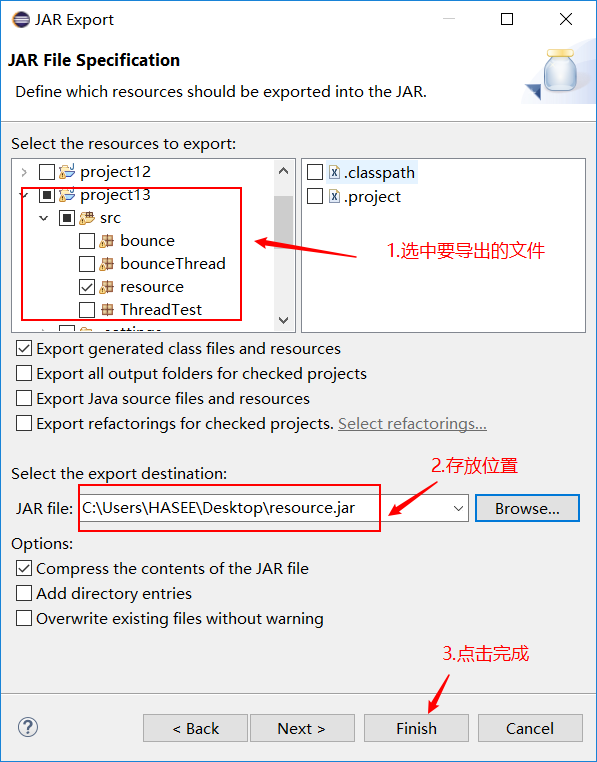


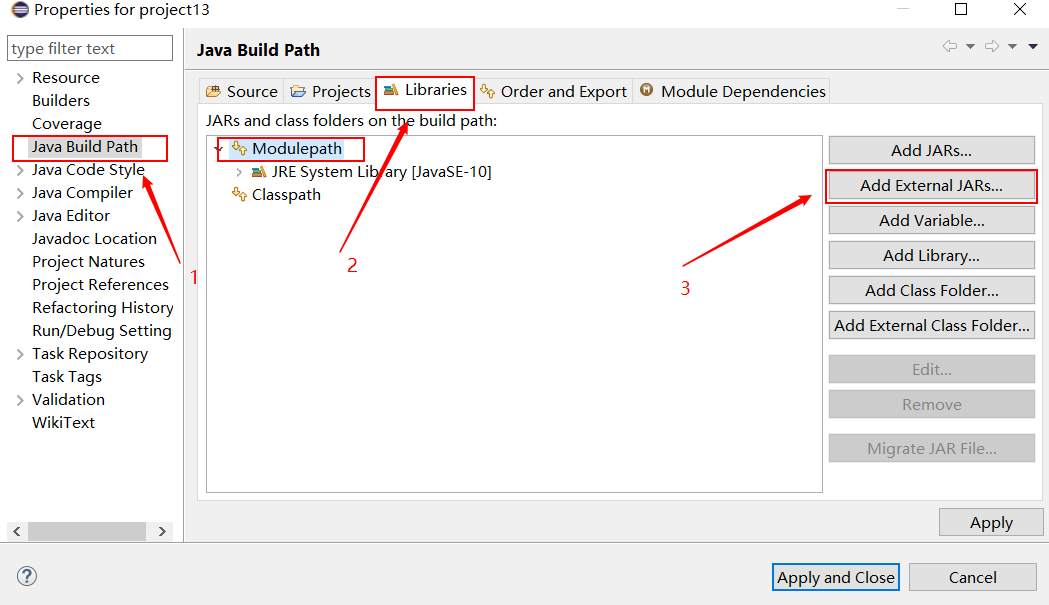
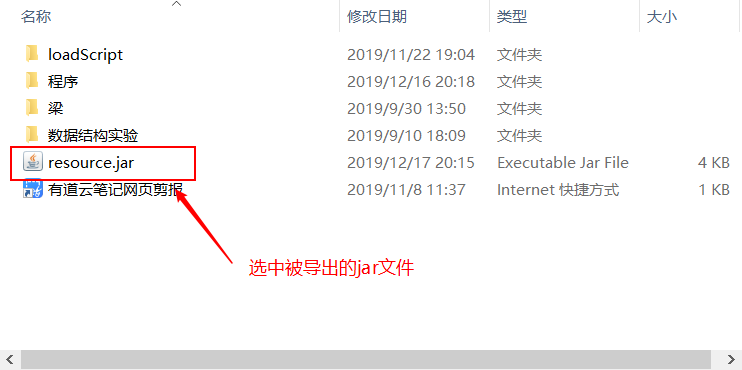
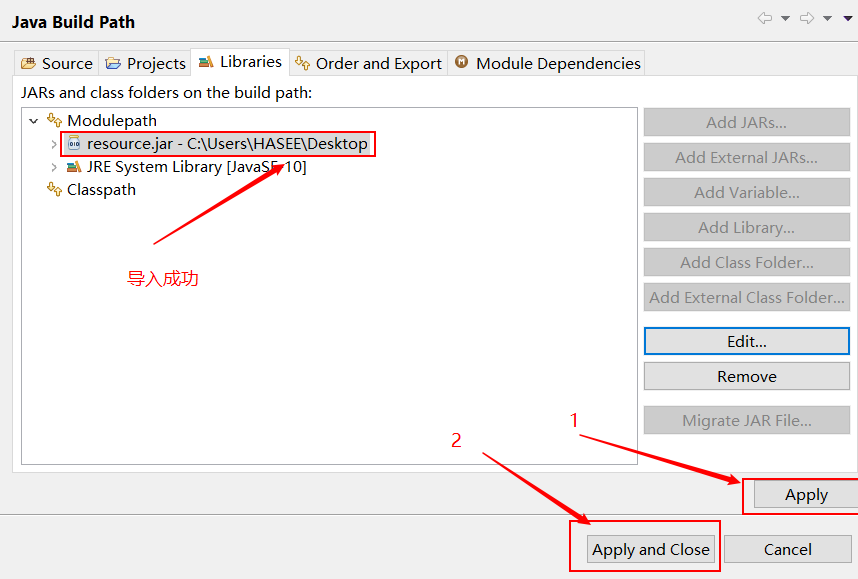
然后我也不知道要怎么处理进行下一步了……
测试程序2:
l 在elipse IDE中调试运行ThreadTest,结合程序运行结果理解程序;
l 掌握线程概念;
l 掌握用Thread的扩展类实现线程的方法;
l 利用Runnable接口改造程序,掌握用Runnable接口创建线程的方法。
package ThreadTest;
class Lefthand extends Thread {
public void run()
{
for(int i=0;i<=5;i++)
{ System.out.println("You are Students!");
try{ sleep(500); }// 休眠时间为500毫秒
catch(InterruptedException e)// 阻塞状态
{ System.out.println("Lefthand error.");}
}
}
}
class Righthand extends Thread {
public void run()
{
for(int i=0;i<=5;i++)
{ System.out.println("I am a Teacher!");
try{ sleep(300); }// 休眠时间为300毫秒
catch(InterruptedException e)
{ System.out.println("Righthand error.");}
}
}
}
public class ThreadTest
{
static Lefthand left;
static Righthand right;
public static void main(String[] args)
{ left=new Lefthand();
right=new Righthand();
left.start();
right.start();
}
}
运行结果:
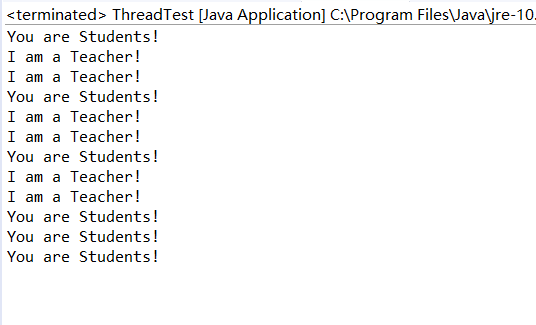
测试程序3:
l 在Elipse环境下调试教材625页程序14-1、14-2 、14-3,结合程序运行结果理解程序;
l 在Elipse环境下调试教材631页程序14-4,结合程序运行结果理解程序;
l 对比两个程序,理解线程的概念和用途;
l 掌握线程创建的两种技术。
程序14-1:
package bounce;
import java.awt.*;
import java.awt.event.*;
import javax.swing.*;
/**
* 显示一个动画弹球。
* @version 1.34 2015-06-21
* @author Cay Horstmann
*/
public class Bounce
{
public static void main(String[] args)
{
EventQueue.invokeLater(() -> {
JFrame frame = new BounceFrame();
frame.setDefaultCloseOperation(JFrame.EXIT_ON_CLOSE);
frame.setVisible(true);
});
}
}
/**
* 框架与球组件和按钮。
*/
class BounceFrame extends JFrame
{
private BallComponent comp;
public static final int STEPS = 1000;
public static final int DELAY = 3;
/**
* Constructs the frame with the component for showing the bouncing ball and
* Start and Close buttons
*/
public BounceFrame()
{
setTitle("Bounce");
comp = new BallComponent();
add(comp, BorderLayout.CENTER);
JPanel buttonPanel = new JPanel();
addButton(buttonPanel, "Start", event -> addBall());
addButton(buttonPanel, "Close", event -> System.exit(0));
add(buttonPanel, BorderLayout.SOUTH);//将buttonPanel组件整体放在南端
pack();
}
/**
* 将按钮添加到容器中。
* @param c the container
* @param title the button title
* @param listener the action listener for the button
*/
public void addButton(Container c, String title, ActionListener listener)
{
JButton button = new JButton(title);
c.add(button);
button.addActionListener(listener);
}
/**
* 添加一个弹跳球到面板,使它弹跳1000次。
*/
public void addBall()
{
try
{
Ball ball = new Ball();
comp.add(ball);
for (int i = 1; i <= STEPS; i++)
{
ball.move(comp.getBounds());//调用move方法
comp.paint(comp.getGraphics());
Thread.sleep(DELAY);//调用线程的sleep方法
}
}
catch (InterruptedException e)
{
}
}
}
程序14-2:
package bounce;
import java.awt.geom.*;
/**
*在矩形的边缘上移动和弹回的球
* @version 1.33 2007-05-17
* @author Cay Horstmann
*/
public class Ball
{
private static final int XSIZE = 15;
private static final int YSIZE = 15;
private double x = 0;
private double y = 0;
private double dx = 1;
private double dy = 1;
/**
* 将球移动到下一个位置,如果它击中其中一条边,则反向移动
*/
//判断球的边界所处状态的四个条件
public void move(Rectangle2D bounds)
{
x += dx;
y += dy;
if (x < bounds.getMinX())
{
x = bounds.getMinX();
dx = -dx;
}
if (x + XSIZE >= bounds.getMaxX())
{
x = bounds.getMaxX() - XSIZE;
dx = -dx;
}
if (y < bounds.getMinY())
{
y = bounds.getMinY();
dy = -dy;
}
if (y + YSIZE >= bounds.getMaxY())
{
y = bounds.getMaxY() - YSIZE;
dy = -dy;
}
}
/**
* 获取当前位置的球的形状。
*/
public Ellipse2D getShape()
{
return new Ellipse2D.Double(x, y, XSIZE, YSIZE);
}
}
程序14-3:
package bounce;
import java.awt.*;
import java.util.*;
import javax.swing.*;
/**
* 绘制球的组件。
* @version 1.34 2012-01-26
* @author Cay Horstmann
*/
public class BallComponent extends JPanel
{
private static final int DEFAULT_WIDTH = 450;
private static final int DEFAULT_HEIGHT = 350;
private java.util.List<Ball> balls = new ArrayList<>();
/**
* 向组件添加一个球。
* @param b the ball to add
*/
public void add(Ball b)
{
balls.add(b);
}
public void paintComponent(Graphics g)
{
super.paintComponent(g); // erase background
Graphics2D g2 = (Graphics2D) g;
for (Ball b : balls)
{
g2.fill(b.getShape());
}
}
public Dimension getPreferredSize() { return new Dimension(DEFAULT_WIDTH, DEFAULT_HEIGHT); }
}
运行结果:

程序14-4:
package bounceThread;
import java.awt.*;
import java.awt.event.*;
import javax.swing.*;
/**
* Shows animated bouncing balls.
* @version 1.34 2015-06-21
* @author Cay Horstmann
*/
public class BounceThread
{
public static void main(String[] args)
{
EventQueue.invokeLater(() -> {
JFrame frame = new BounceFrame();
frame.setTitle("BounceThread");
frame.setDefaultCloseOperation(JFrame.EXIT_ON_CLOSE);
frame.setVisible(true);
});
}
}
/**
* The frame with panel and buttons.
*/
class BounceFrame extends JFrame
{
private BallComponent comp;
public static final int STEPS = 1000;
public static final int DELAY = 5;
/**
* Constructs the frame with the component for showing the bouncing ball and
* Start and Close buttons
*/
public BounceFrame()
{
comp = new BallComponent();
add(comp, BorderLayout.CENTER);
JPanel buttonPanel = new JPanel();
addButton(buttonPanel, "Start", event -> addBall());
addButton(buttonPanel, "Close", event -> System.exit(0));
add(buttonPanel, BorderLayout.SOUTH);
pack();
}
/**
* Adds a button to a container.
* @param c the container
* @param title the button title
* @param listener the action listener for the button
*/
public void addButton(Container c, String title, ActionListener listener)
{
JButton button = new JButton(title);
c.add(button);
button.addActionListener(listener);
}
/**
* Adds a bouncing ball to the canvas and starts a thread to make it bounce
*/
public void addBall()
{
Ball ball = new Ball();
comp.add(ball);
//引用实现了Runnable的方法
Runnable r = () -> {
try
{
for (int i = 1; i <= STEPS; i++)
{
ball.move(comp.getBounds());
comp.repaint();
Thread.sleep(DELAY);
}
}
catch (InterruptedException e)//捕获异常
{
}
};
Thread t = new Thread(r);//用Runnable创建一个Thread对象
t.start();//启动线程
}
}
package bounceThread;
import java.awt.*;
import java.util.*;
import javax.swing.*;
/**
* The component that draws the balls.
* @version 1.34 2012-01-26
* @author Cay Horstmann
*/
public class BallComponent extends JComponent
{
private static final int DEFAULT_WIDTH = 450;
private static final int DEFAULT_HEIGHT = 350;
private java.util.List<Ball> balls = new ArrayList<>();
/**
* Add a ball to the panel.
* @param b the ball to add
*/
public void add(Ball b)
{
balls.add(b);
}
public void paintComponent(Graphics g)
{
Graphics2D g2 = (Graphics2D) g;
for (Ball b : balls)
{
g2.fill(b.getShape());
}
}
public Dimension getPreferredSize() { return new Dimension(DEFAULT_WIDTH, DEFAULT_HEIGHT); }
}
package bounceThread;
import java.awt.geom.*;
/**
A ball that moves and bounces off the edges of a
rectangle
* @version 1.33 2007-05-17
* @author Cay Horstmann
*/
public class Ball
{
private static final int XSIZE = 15;
private static final int YSIZE = 15;
private double x = 0;
private double y = 0;
private double dx = 1;
private double dy = 1;
/**
Moves the ball to the next position, reversing direction
if it hits one of the edges
*/
public void move(Rectangle2D bounds)
{
x += dx;
y += dy;
if (x < bounds.getMinX())
{
x = bounds.getMinX();
dx = -dx;
}
if (x + XSIZE >= bounds.getMaxX())
{
x = bounds.getMaxX() - XSIZE;
dx = -dx;
}
if (y < bounds.getMinY())
{
y = bounds.getMinY();
dy = -dy;
}
if (y + YSIZE >= bounds.getMaxY())
{
y = bounds.getMaxY() - YSIZE;
dy = -dy;
}
}
/**
Gets the shape of the ball at its current position.
*/
public Ellipse2D getShape()
{
return new Ellipse2D.Double(x, y, XSIZE, YSIZE);
}
}
运行结果:
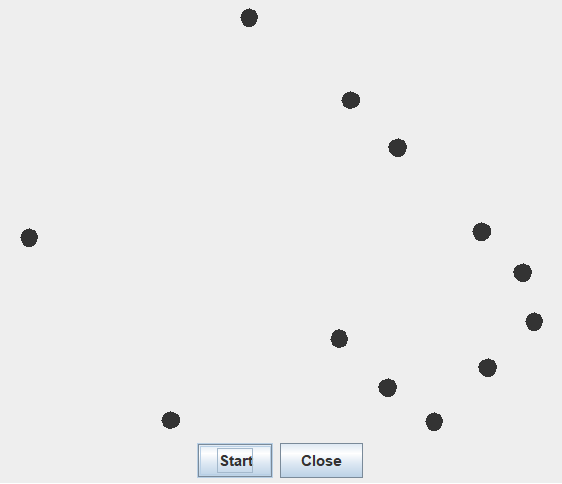
两个实验对比:第一个程序非线程的,执行一次程序要等执行完才能执行下一次;第二个程序是线程的,执行第一次程序不用等执行完可以接着执行第二次操作。
实验总结:
本周学习了Java应用程序的打包操作,有些地方还不太理解来…;我初步了解学习了关于线程的知识,并初步掌握了线程创建的两种方法。1)用Thread类的子类创建线程(2)用Runnable()接口实现线程;理解和掌握了线程的优先级属性及调度方法,学到了线程的七种状态。